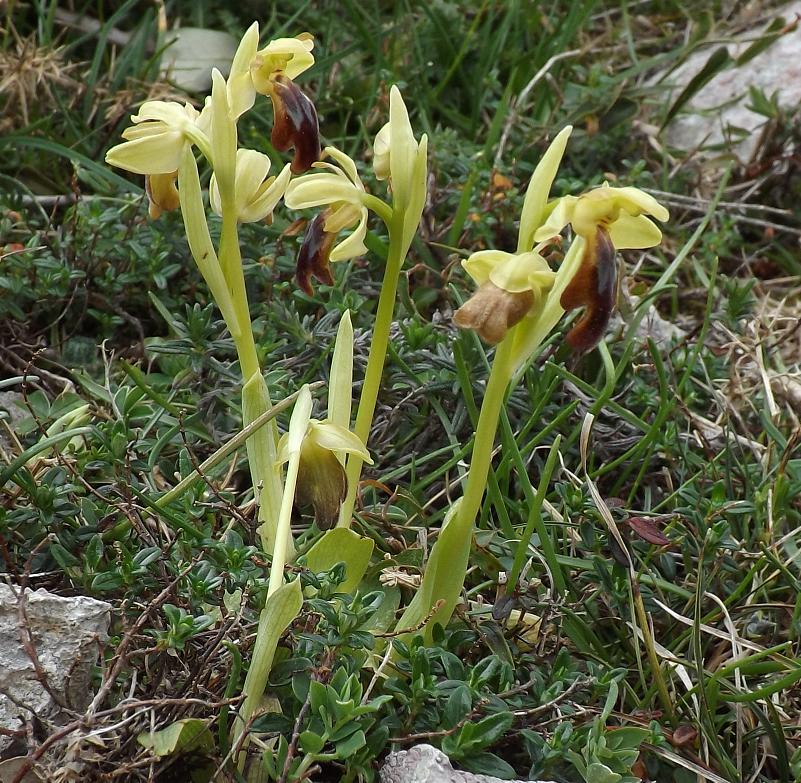The first blooming orchids we will be able to observe at the end of this winter in the north of Spain can be found in the autonomous region of Asturias, located in the milder parts of the northern Cantabrian Mountains. We are talking about the giant orchid ( Himantoglossum robertianum, formerly classified as Barlia robertiana) and the somber bee-orchid ( Ophrys fusca ), also called the dark bee-orchid. The giant orchid will already be blooming in the second half of February and most of the somber bee-orchids will flower in March. The giant orchid is certainly not a common orchid in the Cantabrian Mountains, but we still managed to locate some groups with up to 20 flowering specimens. I know that this is nothing compared with certain regions in Portugal where I´ve seen literally thousands of giant orchids, but I´m very glad we have some of them around in our region too. Of the Ophrys fusca we have found a very promising area right on the seashore with hundreds of plants in bloom and also some hitherto unknown smaller populations scattered around Asturias, at least unknown according to the specialised literature.
The giant orchid is indeed a very large orchid, with a height of up to 1 meter, a big rosette and broad leaves. The picture shows clearly the sheathing leaves which wrap around the stem. This orchid is hard to confuse with other orchids, also because of its large size and the very early time of flowering. For example, in Portugal I've seen lots of blooming specimens in the first half of February.
The flowering spike has a large number of flowers that are close to each other.
The individual flowers can reach up to 4 cm in size, of which the lip alone can be more than 2 cm.
The green striped sepals and upper petals are more or less bent around the gynostemium (reproductive structure of orchids), of which the stigma is clearly visible. For more information about the morphology of an orchid flower see the post "Structure of an orchid flower."
One of the typical habitat of the giant orchid, a rocky and sunny edge of a footpath. There are four orchids with spikes and several rosettes without them.
A small group of somber bee-orchids, all of which just have come into blooming.
Side view of the flower of an Ophrys fusca. The groove in the upper part of the lip is clearly visible. The lip also has hairlike structures that imitate the body of a female bee.
These somber bee-orchids stand in the middle of a path, and when I returned a week later they were all eaten by some goats.










Hallo Marius
ReplyDeletePrachtige opname.
Voor jou fijne dagen en een goed 2014.
Groeten Bets
Bedankt Bets, en voor jou natuurlijk ook een heel fijn jaar.
ReplyDeleteGroetjes, Marius
Mooi om te zien, Marius. Die Giant Orchid moet wel heel indrukwekkend zijn om 'm in het echt te zien. In eerste instantie vond ik 'm wel wat op de Acanthus mollis lijken. De bloemsteel dan, want het rozet lijkt er helemaal niet op. Mooi als je dat om je heen hebt. De Black Orchid is ook prachtig. Groetjes, Joke
ReplyDeleteP.S.: goede dagen en een gezond 2014! Dat we maar veel moois van je mogen zien op het blog.
Hallo Joke, ja misschien wel een beetje, maar bij de reuzenorchis (giant orchid of Himantoglossum robertianum) heeft elke ondergondseknol één rozet en één bloemstengel. Lijken er soms meerder stengels te zijn dan komt dit doordat de knol zich heeft gesplitst. Maar het zijn geen planten met vele stengels, hoewel de stengelvorm er wel wat op lijkt (op de Acanthus).
DeleteEen goed en gezond komend jaar.
Groetjes, Marius
In de Nederlandse versie staat ie al vanaf maart..
ReplyDeleteIk ag mijn reactie daar al staan, en begrijp even niet
waarom je hem weer geplaatst hebt.
Groetjes, Helma
Hallo Helma, de Engelse versies zijn voor de lezers die niet uit Nederland/België komen. Deze blogsite probeert zoveel mogelijk mensen van over de hele wereld te interesseren voor dit onbekende gebergte, vandaar dat de hoofdtaal Engels is. Daarentegen wil ik de Nederlanders niet vergeten, per slot ben ik dat ook, en daarom zijn er ook veel posts in het Nederlands. De eerste keer dat een post (of blogje) wordt geplaatst kan dat in het Nederlands of het Engels zijn. De vertaling komt wanneer ik tijd heb (dat komen we allemaal meestal wel te kort) zodat uiteindelijk alle posts in 2 talen te lezen zijn. Elke post heeft een verwijzing naar de andere post, zodat een lezer die bij een post in de verkeerde taal komt die toch kan lezen (veel lezers vinden de site via de foto´s). Omdat uiteindelijk de Engelse posts bovenaan in de "meanstream" blijven, ben ik me ervan bewust dat de Nederlandse posts moeilijker te vinden zijn. Vandaar dat ik toevallig net gisteren een nieuwe page heb toegevoegd met posts in het Nederlands (in de horizontale balk onder de intro-foto).
DeleteMisschien een beetje lang geworden, maar ik wilde het toch even uitleggen.
Groetjes, Marius
Hallo, il heb gezien dat u een kindle versie hebt van de wilde bloemen van Cantabria, enig mooi.. Hebt u geen boek versie aubl, zodat ik deze kan meenemen als gids in de bergen? Mvg Christiana
ReplyDelete.